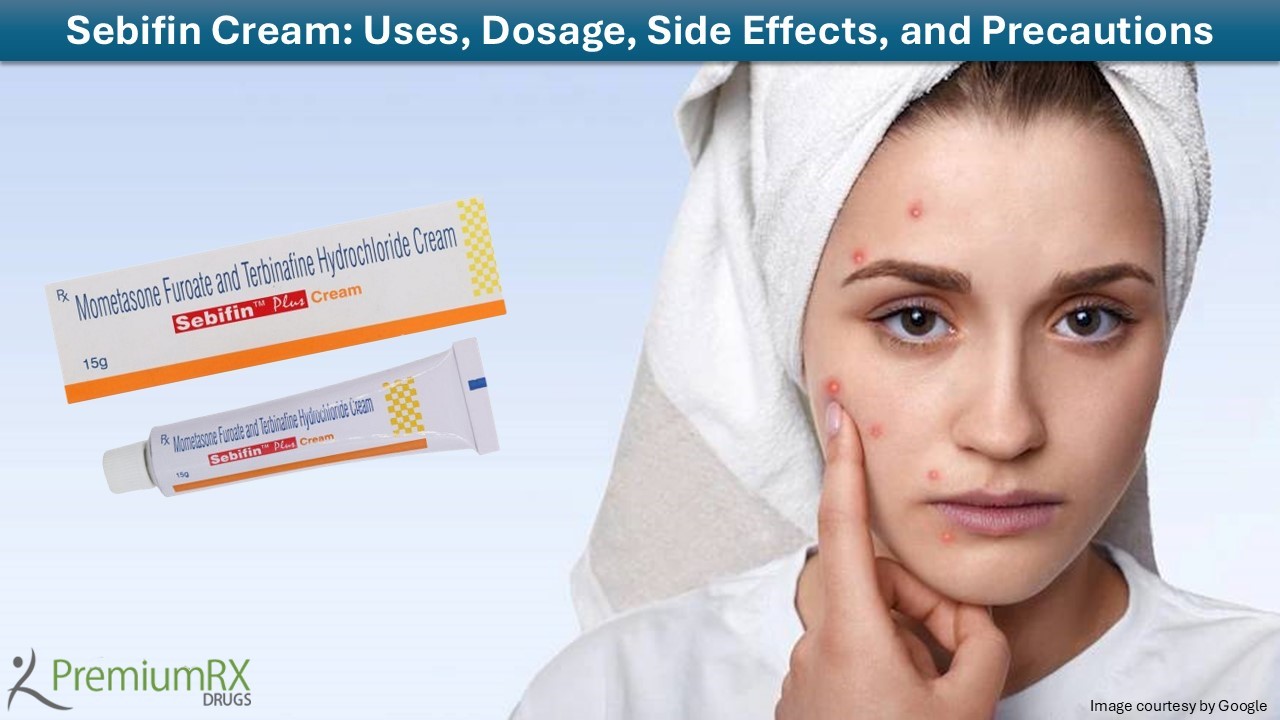Sebifin cream is a topical treatment for fungal skin infections, including those of the fingernails and toenails. Let’s explore how Sebifin helps with fungal infections, including its other uses, dosages, precautions, and potential side effects.
About Sebifin cream
Sebifin treats ringworm infections of the groin region and the body. It treats tinea infections of the feet, commonly referred to as athlete’s foot. Fix an appointment with a healthcare professional to confirm the type of fungal skin infection you have. Your healthcare specialist can determine if Sebifin is the right product for you. The treatment should be followed under the supervision of a healthcare professional. There is a chance that some traces of the infection may still be present at the end of the treatment, which will gradually diminish.
Working
The active ingredient in the Sebifin cream is Terbinafine, which interferes with the production of a certain substance called ergosterol that fungi require for growth, causing the accumulation of another substance, squalene, in the cells. Both of these actions are believed to be responsible for killing the fungus and eliminating the infection.
Proper usage and dosage
- To clear the infection completely, it is essential to continue using the medicine for the prescribed period, even if your symptoms improve or you start to feel better after a few days of regular application. Since fungal infections are slow to resolve, discontinuing treatment earlier can cause the infection to recur and symptoms to flare up again.
- Follow the appropriate instructions given by your healthcare specialist. Avoid exceeding the recommended dosage. If you suspect that the medicine’s effect is too strong or too weak, inform your healthcare provider. The duration and frequency of treatment typically vary depending on the indication and severity of the infection.
- If Sebifin cream accidentally gets into the patient’s eyes, wipe it out and wash the eye thoroughly with running water. It is important to inform the healthcare provider if the symptoms persist.
- The topical formulation could be irritating to certain skin lesions. Fungal and yeast infections tend to be transmitted to others, so it is best to avoid sharing towels and other personal items. To avoid a recurrence of the infection, clothes and towels should be washed frequently.
The application method of Sebifin cream
- Sebifin cream can be applied one or two times a day.
- The area to be treated should be cleansed and dried before application of the antifungal cream.
- A thin formulation layer should be applied only to the affected skin and surrounding areas.
- The cream needs to be rubbed in lightly.
- In cases of infections such as those in the breasts, between the toes/buttocks, and around the groin, the application of cream may be covered with a gauze strip, especially at night. Consult your healthcare expert to learn more about the use of Sebifin in cases of skin-related infections.
- If no visible improvement is seen after two weeks of regular application, please inform your healthcare professional.
Sebifin and special formulation
- Sebifin should not be used in patients allergic to Terbinafine or other topical preparation ingredients. It should also be avoided in patients with chronic or active liver disorders.
To minimise the risk of side effects and ensure safe use, consult your healthcare provider before applying terbinafine cream if any of the following apply to you:
- Have or have a history of renal or hepatic insufficiency, serious skin reactions, blood diseases, or alcohol abuse
- Are you pregnant or planning to conceive while using the topical formulation
- Are you breastfeeding or plan to breastfeed? Nursing mothers should avoid applying the product to their breasts, and it is essential to note that infants should not come into contact with areas treated with topical medicine.
Other warnings
Contact your healthcare provider right away while taking Terbinafine if you develop health problems such as:
- Liver symptoms include persistent nausea, vomiting, dark urine, pale stools, loss of appetite, fatigue, and jaundice, characterised by yellowing of the skin and eyes.
- Blood disorder with symptoms including unusual bleeding, sore throat, weakness, bruising, or frequent infections.
- Lupus erythematosus symptoms include joint pain, thickened psoriasis patches, muscle disease/pain, and fever.
Side effects
- Common side effects include nausea, stomach discomfort after meals, abdominal pain, loss of appetite, joint pain, swelling or bloating of the abdomen, skin rashes, headaches, and muscle pain.
- Common ones include dizziness, mood disorders, tiredness, eye disorders, disturbance, and loss of sense of taste. If you suffer from dizziness, avoid driving or operating machinery.
This blog answers some common questions about Sebifin cream, but does not contain all the information about the product. It does not replace a doctor’s prescription. All medicines come with risks and benefits. Therefore, if you have any doubts regarding Sebifin cream, please consult a doctor.
Marie
Latest posts by Marie (see all)
- What is an antifungal cream, and how does it work? - December 19, 2025
- Life with Asthma: How the Right Inhaler Medicine can Change Everything? - December 15, 2025
- Desowen Cream 0.05% for Itching & Rashes: Complete Treatment Guide - December 13, 2025




